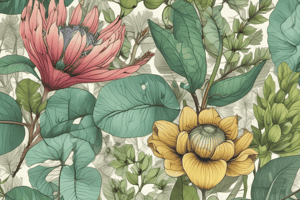Podcast
Questions and Answers
Who was the first person to describe and coin the term 'cell'?
Who was the first person to describe and coin the term 'cell'?
- Robert Hooke (correct)
- Matthias Schleiden
- Theodor Schwann
- Rudolf Virchow
What did Rudolf Virchow propose regarding cell formation?
What did Rudolf Virchow propose regarding cell formation?
- Cells form only from preexisting cells (correct)
- Cells form by free-cell formation, similar to the formation of crystals
- Cells form through a combination of free-cell formation and spontaneous generation
- Cells form through spontaneous generation
Who charged plagiarism against Rudolf Virchow?
Who charged plagiarism against Rudolf Virchow?
- Robert Remak (correct)
- Matthias Schleiden and Theodor Schwann
- John Goodsir and Joseph Goodsir
- Robert Hooke
What did Matthias Schleiden and Theodor Schwann propose about cell formation?
What did Matthias Schleiden and Theodor Schwann propose about cell formation?
What is the main function of a leaf?
What is the main function of a leaf?
According to the Cell Theory, what are cells responsible for?
According to the Cell Theory, what are cells responsible for?
What are the two types of compound leaves mentioned in the text?
What are the two types of compound leaves mentioned in the text?
What is the function of the midrib in a simple leaf (dicot)?
What is the function of the midrib in a simple leaf (dicot)?
Which plant is an example of a palmately compound leaf?
Which plant is an example of a palmately compound leaf?
What is the venation type where leaf veins form a net-like pattern?
What is the venation type where leaf veins form a net-like pattern?
Flashcards are hidden until you start studying
Study Notes
Cell Theory
- Robert Hooke was the first person to describe and coin the term 'cell' in 1665.
- Rudolf Virchow proposed that cells arise from pre-existing cells, contradicting the theory of spontaneous generation.
- Rudolf Virchow was accused of plagiarism by Matthias Schleiden.
Cell Formation
- Matthias Schleiden and Theodor Schwann proposed that cells are the basic units of life and that all living organisms are composed of cells.
Plant Structure
- The main function of a leaf is to carry out photosynthesis.
- According to the Cell Theory, cells are responsible for reproduction, growth, and maintenance of living organisms.
- The two types of compound leaves mentioned are palmate and pinnate leaves.
Leaf Structure
- The midrib is the main vein in a simple leaf (dicot) that provides structural support and transports water and nutrients.
- The horse chestnut is an example of a palmately compound leaf.
- Reticulate venation is the type of venation where leaf veins form a net-like pattern.
Studying That Suits You
Use AI to generate personalized quizzes and flashcards to suit your learning preferences.




